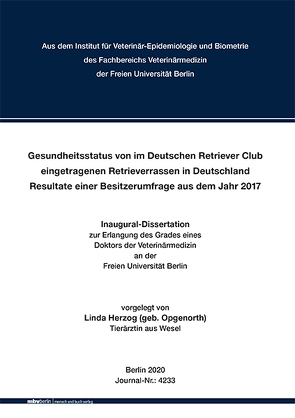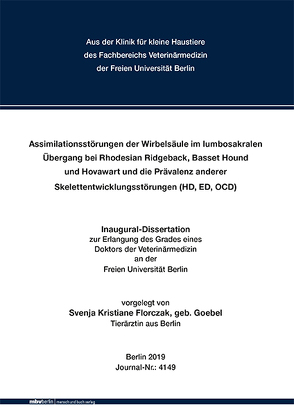
Health status of retriever breeds registered in the German Retriever Club in germany, results of an owner survey from 2017
The study surveyed the disease prevalence in the six retriever breeds registered in the German Retriever Club (DRC). After a literature review of the most frequent diseases of these breeds, data were collected by means of standardized questionnaires which were send to owners of all Retrievers registered in the DRC and could be completed online after registration on their club website. Thus, not only breeding dogs but also family, hunting and therapy dogs of all ages were included in the survey population. For statistical evaluation, the data were transferred to Excel and evaluated with SPSS 25 to determine the current health status of the specific breeds.
The achieved sample size in this cross-sectional study was 896 Retrievers, including all six Retriever breeds. The median life expectancy was 12 years and determined by 125 dogs that had died by the end of the study. Females lived two years longer than males. Median life expectancy of neutered dogs was higher (13 years) when compared to unneutered dogs (9 years). Significant differences between the breeds were observed, e.g. Flat-Coated Retrievers had the lowest median age of only 10 years.
For the study, only disease events which, based on the information provided by the owner, had been diagnosed by a veterinarian, were included in the analysis. On a median, dogs in Four study developed one disease (range 0-10 diseases) throughout their lifetime. Males suffered more frequently from three to four diseases (multimorbidity) when compared to females.
The three most frequently recorded diseases were: otitis externa, hot spots and kennel cough. The most common causes of death were tumors, age, and diseases of the locomotive system and gastrointestinal tract, which ultimately led to euthanasia.
As described in the literature, the more frequently occurring in retrievers were also reported in our study, for example goniodysplasia (1.0%), cataract (2.5%), ichthyosis (1.5%), seizures (1.8%) and hypothyroidism (6.6%).
On the other hand, several diseases described in the literature as frequently occurring could only be documented very rarely (<1%) or not at all in this study: progressive retinal atrophy (0.4%), collie eye anomaly (0.1%), retinal dysplasia (0.2%), various autoimmune diseases (0.1-0.4%), myasthenia gravis (0.2%), subaortic (0.5%) or pulmonary stenosis (0.3%) or incomplete ossification of the humerus condyle (0.1%).
With regard to hip joint and elbow dysplasia, the present study showed a decrease for all retriever breeds when compared to previous studies, this is evidence for a successful breeding strategy.
Other diseases increased compared to previous studies in retriever breeds, such as osteoarthritis (8.4%), water tail (8.0%), conjunctivitis (6.6%), cataract (2.5%) and cryptorchidism (1.3%).
The data collected in this study highlighted significantly higher incidences for certain diseases in individual retriever breeds: Curly-coated retrievers had a significantly higher incidence of otitis media. Flat-coated retrievers of eye diseases such as follicular conjunctivitis, distichiasis and goniodysplasia. Labrador-retrievers were significantly more likely to suffer from lameness, otitis and limber tail syndrome and Nova-scotia-duck-tolling Retrievers from distichiasis, spondylosis, prostate diseases and herniated discs. It is striking, but not statistically significant, that Golden Retrievers were almost the only breed to suffer from otitis and ichthyosis, and together with Labrador Retrievers, seizures were documented more frequently in these two breeds.
The study shows that males were significantly more likely to suffer from kennel cough, arthrosis, food-related allergies, atopic dermatitis, cauda equina syndrome and hypothyroidism. Females, especially neutered ones, were significantly more likely to develop cystitis.
Tumor diseases were recorded with a higher prevalence (21%) than in the comparative study of the retrievers with the data collection from 2004, whereby the dogs in the present study became older than in the comparative study (Brümmer 2008) and tumor diseases increase with age (Klopfleisch 2016). The most tumors (27%) were documented in Chesapeake Bay Retrievers followed by Flat Coated Retrievers (18%). In females, tumors occurred 14% of the time, while males had an 11% occurrence. Mammary tumors occurred almost exclusively in females, being the second most common tumor type documented in this study after lipomas. Castrated dogs were more likely to develop lipomas, breast, spleen, liver and lung tumors when compared with intact dogs. Dogs with tumors reached an age of 10-14 years: Retrievers with osteosarcoma and lung tumors reached 10 years of age, whereas dogs with lipomas, mast cell and mamma tumors reached a median age of 14 years.
For a breeding approval of Retrievers registered in the German Retriever Club, among other things, an examination for hip and elbow dysplasia is mandatory (DRC German Retriever Club 2019) is required. The results of this study show significant improvements in these diseases over the past years, which indicates the success of the breeding work.
For the health of the Retrievers, it is desirable to survey the prevalence of typical diseases for Retriever breeds in regular follow-up studies. By doing so, breeding regulations of the German Retriever Club can always be kept up to date and changes in frequency of diseases can be used as a benchmark for conscientious dog breeding.
Aktualisiert: 2021-04-22
> findR *

Assimilation Disorders of the Vertebral Column at the Lumbosacral Transition in the Rhodesian Ridgeback, Basset Hound and Hovawart and the Prevalence of Other Skeletal Developmental Disorders (HD, ED, OCD)
In the present study, the prevalence of lumbosacral transitional vertebrae (LTV) in three dog breeds (Rhodesian Ridgeback, Basset Hound and Hovawart) and a possible disposition of these breeds for hip dysplasia were examined by means of radiography in ventrodorsal projection. The radiographs were obtained from HD (hip dysplasia) screening examinations and were retrospectively evaluated in relation to LTV. The HD findings were recorded from the case report forms. HD was diagnosed according to the guidelines of the FCI (Federation Cynologique International). For the breed Rhodesian Ridgeback, additionally, the findings concerning elbow joint dysplasia (ED) and osteochondrosis dissecans (OCD) of the humeral head according to the IEWG (International Elbow Working Group) guidelines were taken from the finding sheets and correlated with LTV for the first time in this study.
In total, HD X-rays of N=2402 Rhodesian Ridgebacks, N=249 Basset Hounds and N=116 Hovawarts were available. For N=1815 of the Rhodesian Ridgebacks, radiographs of the elbow joints in the basic image pair (craniocaudal and mediolateral) and N=1788 of the shoulder joints in the medio-lateral projection were available. A total of 154 radiographs were not considered in the context of this evaluation, due to inadequate patient positioning and/or X-ray technique, overlays of the area of interest with faeces or similar disqualifiers in other locations. 427 radiographs went missing, because they had to be sent to the supervising reviewer, but were not returned.
LTV were detected in 6.7% (159/2377) of the dogs in the study population. Rhodesian Ridgebacks were affected in 7.4% (140/2012), Basset Hounds in 2.8% (7/249) and Hovawarts in 2.6% (3/116) of cases. Symmetric LTV were detected in 4.6% (n=109) of the dogs, of which 5.0% (101/2012) were Rhodesian Ridgebacks, 2.0% (5/249) Basset Hounds and 2.6 % (3/116) Hovawarts. The prevalence of asymmetric LTV in this study was 2.1% (50/2012), of which 2.4% (48/2012) where found in Rhodesian Ridgebacks, 0.8% (2/249) in Basset Hounds and none in Hovawarts. A sex disposition could not be proven for any of the breeds.
The LTV findings were correlated with those with HD. For LTV and HD, in general, there was no significant correlation, neither for the entire study population, nor for the individual breeds. For the Rhodesian Ridgeback, the correlation between LTV (149/2012) and higher HD-grades (non-eligible for breeding = HD-grade C, D and E) was statistically significant (p<0,05), likewise for the asymmetric LTV (48/2012) and the HD-grades C, D and E (p <0.05).
There were no significant correlations for other morphological abnormalities in the lumbosacral area, such as a differing number of sacral vertebrae (28/1833) or an altered intervertebral space L7/S1 (141/1825) in the entire study population or in the individual breeds.
The correlation of LTV with disorders from the elbow joint dysplasia complex (ED) and osteochondritis dissecans (OCD) of the humeral head in Rhodesian Ridgebacks were statistically significant (ED 26/1815, FPC 23/1826): for LTV and ED (p <0.01) and its degrees of severity (p <0,05) and LTV and fragmented processus coronoideus (FPC) (p <0.05) and its degrees of severity (p <0.05). The correlations were not significant for OCD of the elbow joint, the isolated processus anconaeus ulnae (IPA), likewise for OCD of the shoulder joint. An intracondylar OCD / incomplete ossification of the humeral condyle (IOHC) did not occur in the study population.
HD also correlated significantly with ED (p <0.001) and its degrees of severity (p <0.001), likewise with FPC (p <0.001) and its degrees of severity (p <0.001). In addition, the correlation between HD and osteochondritis dissecans (OCD) of the elbow joint was significant (p <0.05). The correlations were not statistically significant for the other diseases.
In summary, the results of this study support the literature references that demonstrated positive correlations between LTV and HD. In this study, however, the relationships were only significant for the severe HD forms, as KOMSTA et al. (2015) showed. The significant correlations between HD and ED observed in previous studies could also be confirmed with this work. The correlations of LTV and ED, and OCD, which were also statistically significant, were investigated for the first time in this study.
Aktualisiert: 2019-12-31
> findR *
MEHR ANZEIGEN
Bücher zum Thema dog breeds
Sie suchen ein Buch über dog breeds? Bei Buch findr finden Sie eine große Auswahl Bücher zum
Thema dog breeds. Entdecken Sie neue Bücher oder Klassiker für Sie selbst oder zum Verschenken. Buch findr
hat zahlreiche Bücher zum Thema dog breeds im Sortiment. Nehmen Sie sich Zeit zum Stöbern und finden Sie das
passende Buch für Ihr Lesevergnügen. Stöbern Sie durch unser Angebot und finden Sie aus unserer großen Auswahl das
Buch, das Ihnen zusagt. Bei Buch findr finden Sie Romane, Ratgeber, wissenschaftliche und populärwissenschaftliche
Bücher uvm. Bestellen Sie Ihr Buch zum Thema dog breeds einfach online und lassen Sie es sich bequem nach
Hause schicken. Wir wünschen Ihnen schöne und entspannte Lesemomente mit Ihrem Buch.
dog breeds - Große Auswahl Bücher bei Buch findr
Bei uns finden Sie Bücher beliebter Autoren, Neuerscheinungen, Bestseller genauso wie alte Schätze. Bücher zum
Thema dog breeds, die Ihre Fantasie anregen und Bücher, die Sie weiterbilden und Ihnen wissenschaftliche
Fakten vermitteln. Ganz nach Ihrem Geschmack ist das passende Buch für Sie dabei. Finden Sie eine große Auswahl
Bücher verschiedenster Genres, Verlage, Autoren bei Buchfindr:
Sie haben viele Möglichkeiten bei Buch findr die passenden Bücher für Ihr Lesevergnügen zu entdecken. Nutzen Sie
unsere Suchfunktionen, um zu stöbern und für Sie interessante Bücher in den unterschiedlichen Genres und Kategorien
zu finden. Unter dog breeds und weitere Themen und Kategorien finden Sie schnell und einfach eine Auflistung
thematisch passender Bücher. Probieren Sie es aus, legen Sie jetzt los! Ihrem Lesevergnügen steht nichts im Wege.
Nutzen Sie die Vorteile Ihre Bücher online zu kaufen und bekommen Sie die bestellten Bücher schnell und bequem
zugestellt. Nehmen Sie sich die Zeit, online die Bücher Ihrer Wahl anzulesen, Buchempfehlungen und Rezensionen zu
studieren, Informationen zu Autoren zu lesen. Viel Spaß beim Lesen wünscht Ihnen das Team von Buchfindr.

